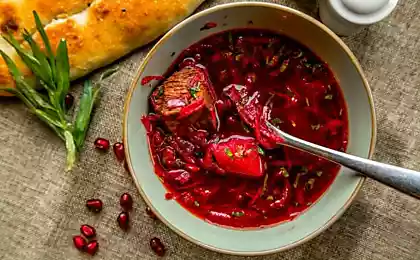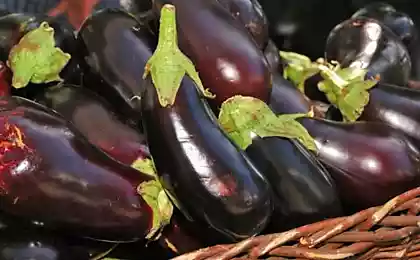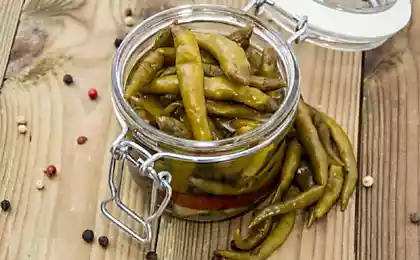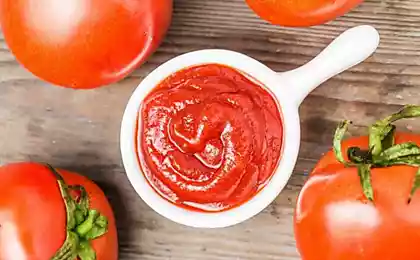838
Ostrenkoe do not want?
It is like an acute, especially all kinds of varieties of pepper. To your attention a small selection of the most common varieties, as well as some exotic varieties. Plus a bit of terminology and the accompanying pictures.
10 photos + text

Let's start with the records. Their most hot chili peppers in the world. Guinness Book of Records has a new achievement. Paul Bolsland, professor of the American University of New Mexico opened the sharpest chili in the world. Record pepper called Bhut Jolokia, which translates as "pepper - ghost" or "pepper - the spirit." "Ghost Pepper" is a natural hybrid of natural and native to Assam, in north-east India. It surpasses the sharpness of the previous champion Red Savina (Red Savina Habanero).
bhut jolokia

During the repetition of the test with measurement of heat in skouvillyah (Scoville heat units (SHUs)), Booth Dzholokia reached one million SHUs, almost double the figure SHUs Red Savina, whose number was 577000.
Dr. Paul Bosland, director of the Institute of Chile Pepper at the State University of New Mexico, collected seeds Bhut Jolokia while visiting India in 2001. Bosland Bhut Jolokia plants cultivated under the pesticide cells for three years to get enough seed to complete the required tests. Bosland argues that intense heat concentration of Bhut Jolokia will not pass unnoticed. Probably now it will be used in the food industry as seasoning in packaged foods.
red savina
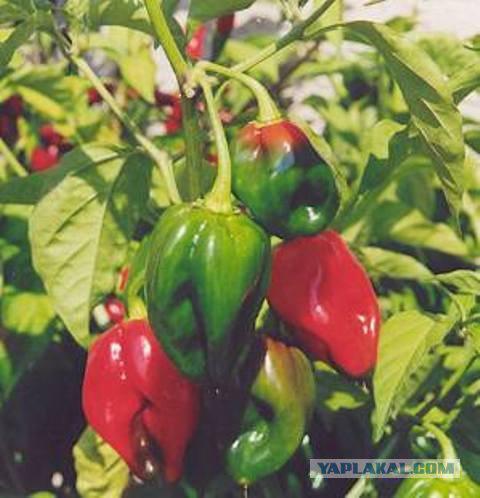
A few words about the paprika and chilli. Human language can recognize capsaicin dilution at 1 in a million. Sharpness is determined by Scoville. She named after its creator - a pharmacist Wilbur Scoville. One point on the scale indicates the specific content in pepper capsaicin - the substance responsible for acute. According to this scale, a simple bell pepper contains from 0 to 100 editsinits acuity, Tabasco sauce 2,500 - 5,000 units, Cayenne 50,000 10,000 Xalapa, habanero to 500,000 units, while the hot pepper varieties Buth Jolokia over 1 million units. Pure capsaicin is drawn to 16,000,000 units, but we have anyway, because after 1 million we cease to recognize the urgency.
dorset naga
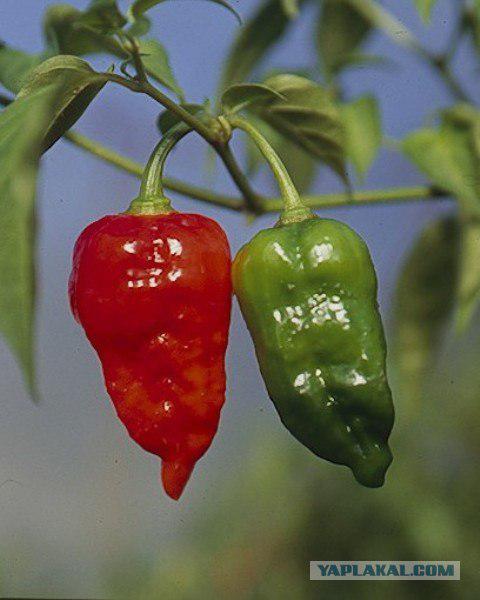
Learn more about capsaicin
As already mentioned above, the nature of the sharpness due to the presence in chilli (capsicum) capsaicin alkaloid, which is produced peppers protection microbial. In addition to the cooking properties of this alkaloid, irritating the upper respiratory tract and skin, are used in medicine. To determine the pungency of hot peppers, there are many ways and one of them, conventional and most common, is to use the Scoville scale. Hot pepper extract dissolved in a sugar syrup, and the number on the Scoville means as shares syrup to come to one share of the extract to zhguchest could not recognize the taste. So, one of the most slabozhguchih varieties of peppers - Pepperonchini - correspond to 100 - 500 units of Scoville, and one of the most acute, Booth Dzholokiya, which is cultivated in Bangladesh, south-east of India and Sri Lanka - 855.000 - 1.050.000. This means that in order to not feel the burning taste, it is necessary to dissolve 1 gram of pepper pulp 1 000 liters of syrup!
jalapeno
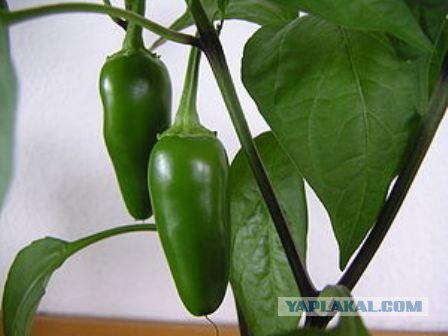
O how strong pure capsaicin can be seen in the example - one milligram of pure capsaicin, put on your hand, it will cause pain as from the red-hot iron and the skin is covered with blisters.
habanero

Medically sharp peppers is very ambiguous. On the one hand, studies show that capsaicin helps fight cancer cells, on the other - immoderate their use in itself can lead to cancer of the stomach, but sometimes there are chili powder carcinogens. Moreover, in any diseases of the stomach or intestine consumption of hot peppers is highly undesirable. In defense of peppers say that their use can help overweight, type 1 diabetes, as well as hinders the negative effects of cholesterol, which is already present in our body.
cayenne
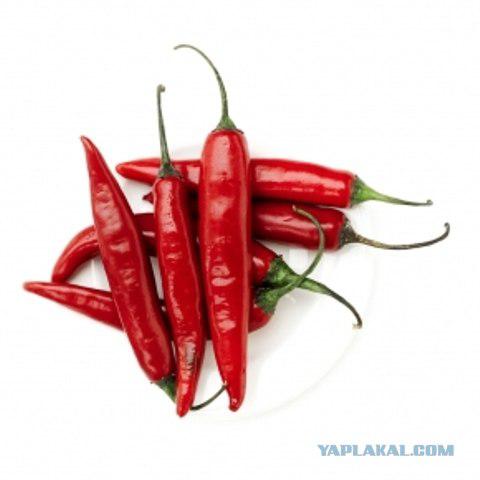
How to extinguish a fire in your mouth? Wash down with water is useless. It gives a minute effect of "cooling" receptors, while capsaicin is distributed uniformly in the oral cavity. It is best to help bind fat-something that dissolves Capsaicin - such as milk, cheese or yogurt.
cascabel
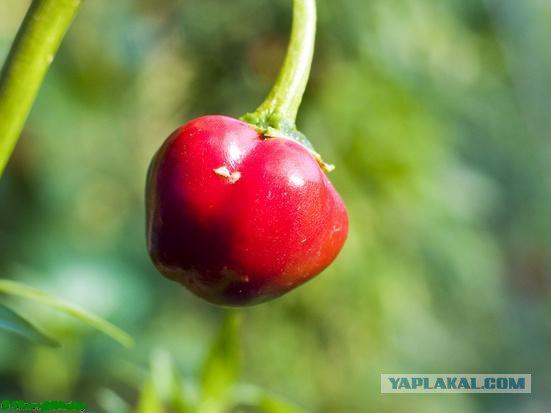
By the way, the birds do not feel the pungency of peppers at all - because of the differences in the nervous system capsaicin has no effect on them, as in mammals, so hot peppers are often a favorite food for the birds without causing any harm to their digestive tract.
peperoncini
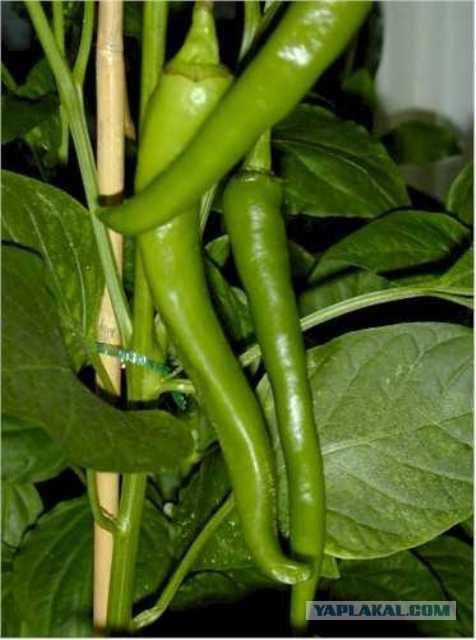
Well, in summary table Scoville:
15 000 000-16 000 000 Pure capsaicin
9 100 000-15 000 000 Capsaicinoids: dihydrocapsaicin, nordigidrokapsaitsin and others.
2000 300 000 000-5 standard pepper spray (USA)
855 000-1 041 427 Buth Jolokia
876 000-970 000 Dorset Naga, Tezpur
350 000-577 000 Red Savina Habanero
100 000-350 000 Habanera (Habanero Chile)
100 000-350 000 Scotch Bonnet, South American chinenses, African birdseye
100 000-200 000 Jamaican hot pepper (Jamaican Hot Pepper)
50 000-100 000 Pepper Thai (Thai Pepper), Malagueta Pepper, Chiltepin Pepper, Tepin,
30 000-50 000 Cayenne Pepper (Cayenne), Aji pepper, Tabasco pepper, Piquin,
10 000-23 000 Serrano Pepper, de Arbol, Crushed Red Pepper
7 000-8 000 Tabasco Sauce (Habanero)
5 000-10 000 Wax Pepper, Early Jalapeso
2 500-8 000 Jalapeno Pepper
2 500-5 000 Tabasco Sauce (Tabasco pepper), Louisiana hot sauce, Pasilla
1 500-2 500 Rocotillo Pepper, Sandia, Cascabel, Yellow Wax Hot
1 000-1 500 Anaheim, Poblano Pepper, Mild Jalepeno
600-800 Tabasco Sauce (Green Pepper)
500-1000 Ancho, ground "Chili»
100-500 Pimiento (Pimenta), (Pepperoncini, Pickled pepperoncini, Hungarian paprika)
0 Bell pepper, Mild Bells, Sweet Banana
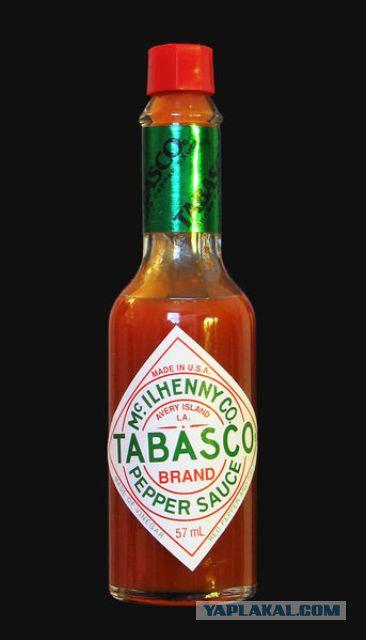
Source:
10 photos + text

Let's start with the records. Their most hot chili peppers in the world. Guinness Book of Records has a new achievement. Paul Bolsland, professor of the American University of New Mexico opened the sharpest chili in the world. Record pepper called Bhut Jolokia, which translates as "pepper - ghost" or "pepper - the spirit." "Ghost Pepper" is a natural hybrid of natural and native to Assam, in north-east India. It surpasses the sharpness of the previous champion Red Savina (Red Savina Habanero).
bhut jolokia

During the repetition of the test with measurement of heat in skouvillyah (Scoville heat units (SHUs)), Booth Dzholokia reached one million SHUs, almost double the figure SHUs Red Savina, whose number was 577000.
Dr. Paul Bosland, director of the Institute of Chile Pepper at the State University of New Mexico, collected seeds Bhut Jolokia while visiting India in 2001. Bosland Bhut Jolokia plants cultivated under the pesticide cells for three years to get enough seed to complete the required tests. Bosland argues that intense heat concentration of Bhut Jolokia will not pass unnoticed. Probably now it will be used in the food industry as seasoning in packaged foods.
red savina

A few words about the paprika and chilli. Human language can recognize capsaicin dilution at 1 in a million. Sharpness is determined by Scoville. She named after its creator - a pharmacist Wilbur Scoville. One point on the scale indicates the specific content in pepper capsaicin - the substance responsible for acute. According to this scale, a simple bell pepper contains from 0 to 100 editsinits acuity, Tabasco sauce 2,500 - 5,000 units, Cayenne 50,000 10,000 Xalapa, habanero to 500,000 units, while the hot pepper varieties Buth Jolokia over 1 million units. Pure capsaicin is drawn to 16,000,000 units, but we have anyway, because after 1 million we cease to recognize the urgency.
dorset naga

Learn more about capsaicin
As already mentioned above, the nature of the sharpness due to the presence in chilli (capsicum) capsaicin alkaloid, which is produced peppers protection microbial. In addition to the cooking properties of this alkaloid, irritating the upper respiratory tract and skin, are used in medicine. To determine the pungency of hot peppers, there are many ways and one of them, conventional and most common, is to use the Scoville scale. Hot pepper extract dissolved in a sugar syrup, and the number on the Scoville means as shares syrup to come to one share of the extract to zhguchest could not recognize the taste. So, one of the most slabozhguchih varieties of peppers - Pepperonchini - correspond to 100 - 500 units of Scoville, and one of the most acute, Booth Dzholokiya, which is cultivated in Bangladesh, south-east of India and Sri Lanka - 855.000 - 1.050.000. This means that in order to not feel the burning taste, it is necessary to dissolve 1 gram of pepper pulp 1 000 liters of syrup!
jalapeno

O how strong pure capsaicin can be seen in the example - one milligram of pure capsaicin, put on your hand, it will cause pain as from the red-hot iron and the skin is covered with blisters.
habanero

Medically sharp peppers is very ambiguous. On the one hand, studies show that capsaicin helps fight cancer cells, on the other - immoderate their use in itself can lead to cancer of the stomach, but sometimes there are chili powder carcinogens. Moreover, in any diseases of the stomach or intestine consumption of hot peppers is highly undesirable. In defense of peppers say that their use can help overweight, type 1 diabetes, as well as hinders the negative effects of cholesterol, which is already present in our body.
cayenne

How to extinguish a fire in your mouth? Wash down with water is useless. It gives a minute effect of "cooling" receptors, while capsaicin is distributed uniformly in the oral cavity. It is best to help bind fat-something that dissolves Capsaicin - such as milk, cheese or yogurt.
cascabel

By the way, the birds do not feel the pungency of peppers at all - because of the differences in the nervous system capsaicin has no effect on them, as in mammals, so hot peppers are often a favorite food for the birds without causing any harm to their digestive tract.
peperoncini

Well, in summary table Scoville:
15 000 000-16 000 000 Pure capsaicin
9 100 000-15 000 000 Capsaicinoids: dihydrocapsaicin, nordigidrokapsaitsin and others.
2000 300 000 000-5 standard pepper spray (USA)
855 000-1 041 427 Buth Jolokia
876 000-970 000 Dorset Naga, Tezpur
350 000-577 000 Red Savina Habanero
100 000-350 000 Habanera (Habanero Chile)
100 000-350 000 Scotch Bonnet, South American chinenses, African birdseye
100 000-200 000 Jamaican hot pepper (Jamaican Hot Pepper)
50 000-100 000 Pepper Thai (Thai Pepper), Malagueta Pepper, Chiltepin Pepper, Tepin,
30 000-50 000 Cayenne Pepper (Cayenne), Aji pepper, Tabasco pepper, Piquin,
10 000-23 000 Serrano Pepper, de Arbol, Crushed Red Pepper
7 000-8 000 Tabasco Sauce (Habanero)
5 000-10 000 Wax Pepper, Early Jalapeso
2 500-8 000 Jalapeno Pepper
2 500-5 000 Tabasco Sauce (Tabasco pepper), Louisiana hot sauce, Pasilla
1 500-2 500 Rocotillo Pepper, Sandia, Cascabel, Yellow Wax Hot
1 000-1 500 Anaheim, Poblano Pepper, Mild Jalepeno
600-800 Tabasco Sauce (Green Pepper)
500-1000 Ancho, ground "Chili»
100-500 Pimiento (Pimenta), (Pepperoncini, Pickled pepperoncini, Hungarian paprika)
0 Bell pepper, Mild Bells, Sweet Banana

Source:














